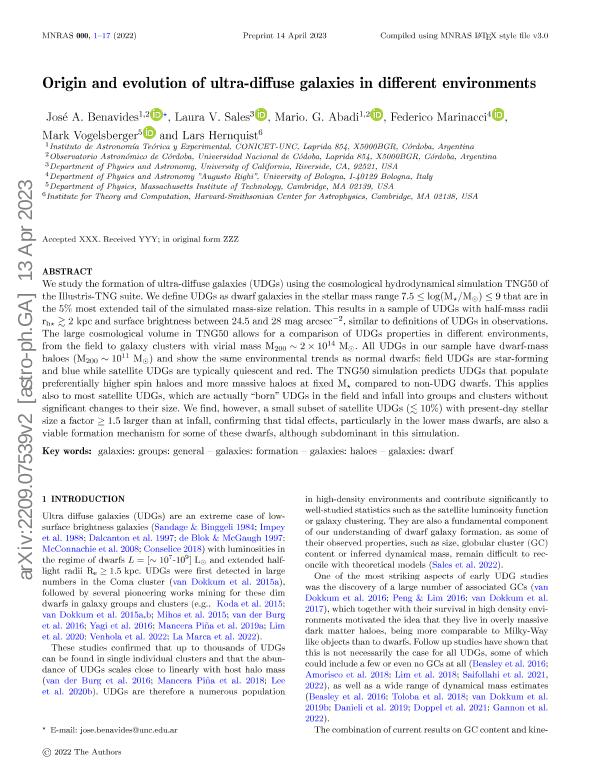Mostrar el registro sencillo del ítem
dc.contributor.author
Benavides, José A.
dc.contributor.author
Sales, Laura V.
dc.contributor.author
Abadi, Mario Gabriel

dc.contributor.author
Marinacci, Federico

dc.contributor.author
Vogelsberger, Mark
dc.contributor.author
Hernquist, Lars
dc.date.available
2024-02-07T15:32:03Z
dc.date.issued
2023-06
dc.identifier.citation
Benavides, José A.; Sales, Laura V.; Abadi, Mario Gabriel; Marinacci, Federico; Vogelsberger, Mark; et al.; Origin and evolution of ultradiffuse galaxies in different environments; Wiley Blackwell Publishing, Inc; Monthly Notices of the Royal Astronomical Society; 522; 1; 6-2023; 1033-1048
dc.identifier.issn
0035-8711
dc.identifier.uri
http://hdl.handle.net/11336/226194
dc.description.abstract
We study the formation of ultradiffuse galaxies (UDGs) using the cosmological hydrodynamical simulation TNG50 of the Illustris-TNG suite. We define UDGs as dwarf galaxies in the stellar mass range 7.5 ≤ log(M★/M☉) ≤ 9 that are in the 5 per cent most extended tail of the simulated mass–size relation. This results in a sample of UDGs with half-mass radii rh★ ≳ 2 kpc and surface brightness between 24.5 and 28 mag arcsec-2, similar to definitions of UDGs in observations. The large cosmological volume in TNG50 allows for a comparison of UDGs properties in different environments, from the field to galaxy clusters with virial mass M200 ∼ 2 × 1014 M☉. All UDGs in our sample have dwarf-mass haloes (M200 ∼ 1011 M☉) and show the same environmental trends as normal dwarfs: field UDGs are star-forming and blue while satellite UDGs are typically quiescent and red. The TNG50 simulation predicts UDGs that populate preferentially higher spin haloes and more massive haloes at fixed M★ compared to non-UDG dwarfs. This applies also to most satellite UDGs, which are actually ‘born’ UDGs in the field and infall into groups and clusters without significant changes to their size. We find, however, a small subset of satellite UDGs (≲ 10 per cent) with present-day stellar size a factor ≥1.5 larger than at infall, confirming that tidal effects, particularly in the lower mass dwarfs, are also a viable formation mechanism for some of these dwarfs, although sub-dominant in this simulation.
dc.format
application/pdf
dc.language.iso
eng
dc.publisher
Wiley Blackwell Publishing, Inc

dc.rights
info:eu-repo/semantics/openAccess
dc.rights.uri
https://creativecommons.org/licenses/by-nc-sa/2.5/ar/
dc.subject
GALAXIES: DWARF
dc.subject
GALAXIES: FORMATION
dc.subject
GALAXIES: GROUPS: GENERAL
dc.subject
GALAXIES: HALOES
dc.subject.classification
Otras Ciencias Naturales y Exactas

dc.subject.classification
Otras Ciencias Naturales y Exactas

dc.subject.classification
CIENCIAS NATURALES Y EXACTAS

dc.title
Origin and evolution of ultradiffuse galaxies in different environments
dc.type
info:eu-repo/semantics/article
dc.type
info:ar-repo/semantics/artículo
dc.type
info:eu-repo/semantics/publishedVersion
dc.date.updated
2024-02-06T13:50:00Z
dc.journal.volume
522
dc.journal.number
1
dc.journal.pagination
1033-1048
dc.journal.pais
Reino Unido

dc.journal.ciudad
Londres
dc.description.fil
Fil: Benavides, José A.. Consejo Nacional de Investigaciones Científicas y Técnicas. Centro Científico Tecnológico Conicet - Córdoba. Instituto de Astronomía Teórica y Experimental. Universidad Nacional de Córdoba. Observatorio Astronómico de Córdoba. Instituto de Astronomía Teórica y Experimental; Argentina
dc.description.fil
Fil: Sales, Laura V.. University of California; Estados Unidos
dc.description.fil
Fil: Abadi, Mario Gabriel. Consejo Nacional de Investigaciones Científicas y Técnicas. Centro Científico Tecnológico Conicet - Córdoba. Instituto de Astronomía Teórica y Experimental. Universidad Nacional de Córdoba. Observatorio Astronómico de Córdoba. Instituto de Astronomía Teórica y Experimental; Argentina
dc.description.fil
Fil: Marinacci, Federico. Universidad de Bologna; Italia
dc.description.fil
Fil: Vogelsberger, Mark. Massachusetts Institute of Technology; Estados Unidos
dc.description.fil
Fil: Hernquist, Lars. Harvard-Smithsonian Center for Astrophysics; Estados Unidos
dc.journal.title
Monthly Notices of the Royal Astronomical Society

dc.relation.alternativeid
info:eu-repo/semantics/altIdentifier/doi/http://dx.doi.org/10.1093/mnras/stad1053
Archivos asociados
